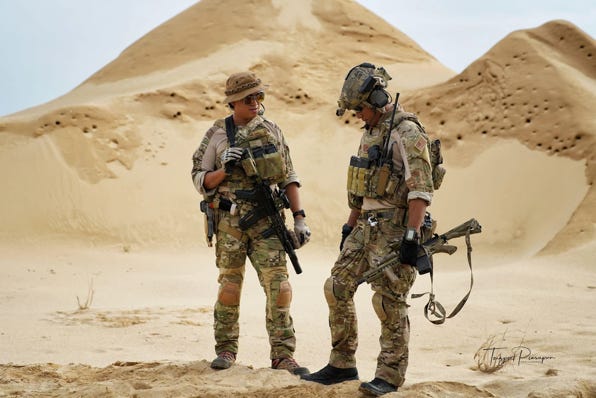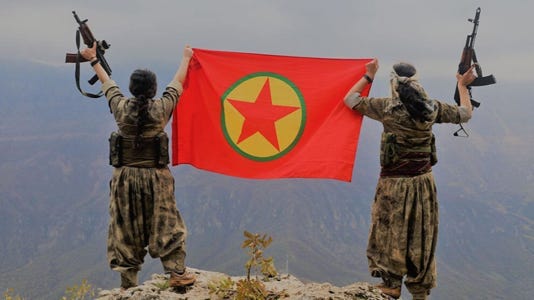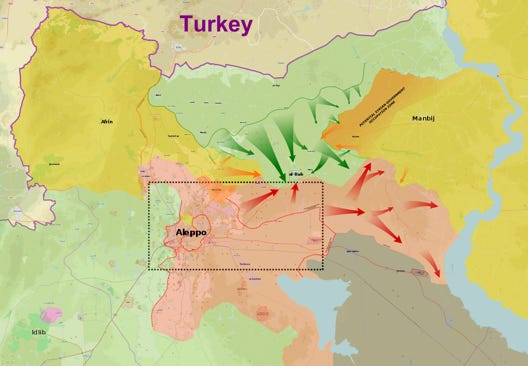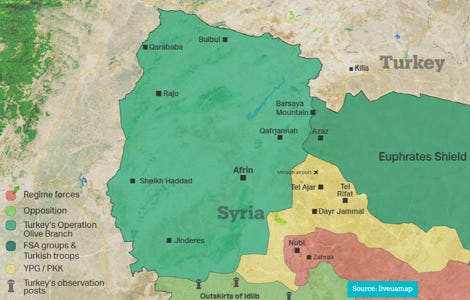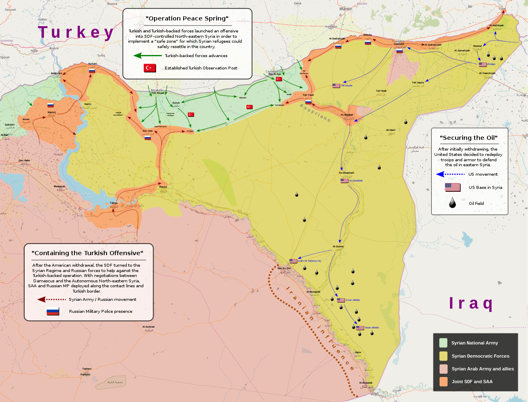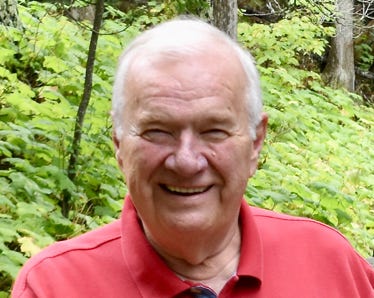DUTY, HONOR, COURAGE, RESILIANCE
Talking Proud: Service & Sacrifice
Syria: A fractured state
Venture into the unfamiliar
Turkey, the Kurds, and the US
Turkey (Türkiye) is an important player in Syria. Turkey means to secure its southern border with Syria. But its ambitions run more than that. Turkey became a republic when the Ottoman Empire dissolved after WWI. Syria, too, was part of the Ottoma Empire.
Turkey’s Ministry of Foreign Affairs is straightforward about the Kurdistan Workers’ Party, the PKK, which it argues has found a haven in Syria,
“Since its foundation in 1984 more than 40 thousand people lost their lives because of PKK terrorism. PKK's ideology is founded on revolutionary Marxism-Leninism and separatist ethno-nationalism. PKK wants to suppress the diversity of Türkiye, prevent participation and integration of Türkiye’s citizens of Kurdish origin and intimidate the people in the region. PKK’s primary targets include police, military, economic, and social assets in Türkiye. PKK also attacks on civilians and diplomatic and consular facilities. PKK is also involved in extortion, arms smuggling, and drug trafficking.”
It is true that the PKK in the 1980s and 1990s conducted raids into Turkey from Syria. That insurgency was bloody. As in many parts of the world, the Kurds wanted greater respect for their rights. Absent that, they chose the option of creating an independent Kurdish state. Turkey was not going to have any of that. The net result was that the Kurds, in the form of the PKK, targeted Turkey’s military and political officials and Kurdish officials they saw as impeding Kurdish autonomy.
The PKK employed a variety of weapons and tactics, including IEDs, car bombs, grenades, small arms, mortars, kidnapping, etc. One result was that the US State Department declared the PKK a foreign terrorist organization in October 1997.
As is always the case, there is another side to the story. Katie Cowen, writing for the Washington Kurdish Institute, describes one perspective,
“The ratification of Turkey’s 1924 constitution stripped Kurdish populations of their political autonomy. The 1924 constitution didn’t allow the Kurdish language to be used in public places, and even the words ‘Kurd’ and ‘Kurdistan’ were forbidden. In 1924 there was also a mandate which forbade Kurdish schools, organizations, and publications from serving their people. Around this time, there was also a law that allowed the expropriation of Kurdish landowners, whose land was given to Turkish-speaking people. These privations and receding autonomy were coupled with deadly massacres of the Kurdish people.”
Martin van Bruinessen adds an economic perspective,
“Traveling from western Turkey to its eastern provinces is like going to an entirely different country—more primitive, poorer, with starker social contradictions …
“Many people there speak Kurdish rather than Turkish. According to many Turkish politicians or academics, this linguistic peculiarity is yet another indication of the area’s backwardness. In the official Turkish view, the Kurds are of Turkish origin, but they have culturally and linguistically degenerated and now speak a gibberish comprised of Persian, Arabic and Turkish and incapable of expressing sophisticated thought.
“Kurdish nationalists also see a causal connection between the underdevelopment of the eastern provinces and the fact that they are largely inhabited by Kurds. They regard this underdevelopment as the result, at least in part, of purposeful Turkish government policy which expressly impeded the development of the eastern provinces out of fear that economic and educational progress might rekindle the Kurds’ nationalist demands.”
The Government of the United Kingdom has taken a more sanguine, less pejorative view of the Kurdish situation in Turkey,
“In recent decades, significant Kurdish populations have settled in Istanbul and other major cities in western Turkey where they are generally afforded greater economic opportunities than in the southeast, and where a Kurdish middle class is growing.
“However, there is evidence of both state and societal discrimination towards Kurds based on their ethnicity. In the past discriminatory practices have historically had some impact on the ability of some Kurds to speak Kurdish in public, and obtain senior employment positions.
“However, in general, Kurds can participate normally in both private and civic life.”
Today, the Government of Turkey’s policy has been clear when it comes to Kurds in Syria: The Kurdish PKK political party is a terrorist organization. The YPG is the PKK’s military arm. The YPG is the centerpiece of the SDF, the American ally on the ground in the fight against IS. On this subject, Turkey and the US stand opposed.
It is uncomfortable for the US and Turkey to stand opposed on this issue. Rick Francona, a retired USAF officer and former member of the Defense Attache staff at the US embassy in Damascus, has said the US arrangement with the SDF is tactical, while the US-NATO relationship with Turkey is strategic.
The Turkey-US relationship is a difficult one. As each day passes, the gap between Turkey’s and US interests widens. The US is clear: degrade and destroy IS. It needs the SDF to do that. Turkey’s objectives are not as clear, though they have become more apparent recently. Turkey’s complaints about past PKK terrorism are valid, but Turkey’s record with the Kurds is far from innocent.
Turkey’s leadership seems to have its vision of Islamist governance, not only at home but elsewhere, Syria included. Turkey has juggled a variety of Syrian opposition groups and elements of the Syrian Army to strengthen its military position in northwestern Syria, and it appears intent on moving eastward, targeting the SDF Kurds, an American ally.
President Erdogan supported the rebels against Assad, including Hayat Tahrir al-Sham (HTS), which now says it is in control of Syria. HTS has ties to the Al-Nusra Front, which in turn has ties to al-Qaeda. Despite these linkages, HTS has taken charge of part of Syria.
There is a view, especially in Europe, that HTS could not have deposed Assad without President Erdogan’s unspoken support, perhaps even approval. This evolution seems to put Erdogan in the driver’s seat, at least for now. The Kurds remain a problem for him. There is some cause to believe efforts are underway to solve this problem. I’m not sure we should hold our breath.
The Erdogan government in Ankara has conducted a deliberate set of military interventions in Syria, all in the name of protecting its borders from the Kurds, which could be translated to mean protecting Turkey from the creation of a Kurdish state that might include Turkish territory. To that end, Turkey also does not want to see a “Western Kurdistan” evolve in Syria.
I think Salim Çevik has said it well,
“Turkey conducted three military operations (in 2016, 2018, and 2019) that specifically aimed to prevent the formation of politically autonomous regions along the Turkish border controlled by the Kurdish-dominated YPG militants.
“In Syria, despite three military operations and large deployments of Turkey’s military, almost one-third of the Syrian territory still remains under SDF control. While Turkey conducts targeted drone attacks against the SDF high command, it cannot break the SDF’s control in these regions without another massive ground operation.”
Therein lies the rub for Erdogan.
Let’s look at these three Turkish military operations.
The 2016-2017 Turkish “Operation Euphrates Shield” was designed to drive IS and the Kurdish YPG (SDF) out of Syria’s northwest border region. According to the Council on Foreign Relations, Turkey sent an armored battalion and supporting ground forces into northern Syria west of the Euphrates River Valley roughly to the border of the AANES’s Afrin canton and southward to Al Bab. Recall that Afrin is one of the AANES’ administrative regions.
The 2018 “Operation Olive Branch” extended Turkey’s control from Aleppo to Afrin and Manbij. This offensive brought the Turkish military into contact with the US SDF ally, most notably in the AANES Afrin region. Turkey hoped to dissuade the US from its alliance with the SDF.
The 2019 “Operation Peace Spring” targeted the SDF. Turkey hoped to expel the SDF from the border area south of a 20-mile safe zone. Arrangements were made with the US to withdraw SDF forces from this safe zone. Furthermore, Turkey and Russia agreed to conduct combined patrols in the area. Keep “arrangement” in mind.
I have said the US and Turkey stand opposed on the subject of Syria. Steven A. Cook of the Council on Foreign Relations uses the term “antagonist” rather than “standing opposed.” Cook has commented that Turkey “is not a partner of the United States. Unlike in previous eras, Washington and Ankara no longer share overarching threats or interests that bind them together. Washington can work with Ankara where it remains possible, work around the Turks where it is necessary, and work against them where it has to.”
Suffice it to say that the US and Turkey are at loggerheads in the case of Syria. However, President Trump created considerable confusion about US policy toward Syria in October 2019.
On October 6, 2019, President Trump, in a phone call with President Erdogan, agreed to a partial withdrawal of US ground and SDF forces in northern Syria in response to Erdogan’s desire to create a buffer zone in the north of Syria along its border.
On October 9, Turkish military forces moved into northern Syria to establish a 20-mile buffer zone. Turkey’s Operation Peace Spring applies.
On October 14, 2019, Trump said US forces had defeated ISIS and “liberated 100 percent of ISIS’s ruthless territorial caliphate … I am withdrawing the remaining United States service members from northeast Syria. As United States forces have defeated the ISIS physical caliphate, United States troops coming out of Syria will now redeploy and remain in the region to monitor the situation and prevent a repeat of 2014, when the neglected threat of ISIS raged across Syria and Iraq.”
To the surprise of many, on the same day, October 14, Trump imposed a series of economic sanctions on Turkey, punishing it for its “destablizing actions in northeast Syria.” Frankly, this did not make sense to me since on this same day, he ordered the withdrawal of US forces from the border area in response to Erdogan’s desire to set up a buffer zone, to wit, Operation Peace Spring.
Three days later, on October 17, Trump announced that the US and Turkey had agreed to a ceasefire. Specifically, he said,
“Turkey has agreed to pause its offensive for 120 hours to allow the United States to facilitate the withdrawal of YPG forces from the Turkish-controlled safe zone. Turkey has agreed to a permanent ceasefire upon completion of the YPG withdrawal. The U.S. has already begun to facilitate the YPG withdrawal from the safe zone area.”
Interestingly, Trump referred to the Kurds as “YPG” and not “SDF.”
The Trump decision caused the US to pull back its ground forces from northern Syria. The Turks set up a 75-mile long, 20-mile deep buffer zone. US officials clarified that the US did not support the Turkish action but would not block it.
Turkey’s military has remained in northern Syria since 2016. US ground forces have also stayed in Syria east of the Euphrates River and at al-Tanf in southern Syria. I will discuss this later, but I believe the US ground force was about 2,000 in 2019, maybe 900, or somewhere between.
Devorah Margolin underscores my sense for Erdogan’s objectives,
“(Turkey and its proxies) are looking to utilize the current chaos to rewrite the map in Turkey’s favor. They are using the distraction of Damascus to continue to grab power during this time of chaos and to undermine the S.D.F., ensuring its negotiating power is weakened.”
US-Turkey relations have soured. Turkish military forces have exchanged fire with the US-backed SDF, most recently near Manbij. I suspect we have not heard the last of this. President Trump has long wanted to get out of Syria. It is hard to know which way he will go on this subject.
Click to zoom graphic-photo
